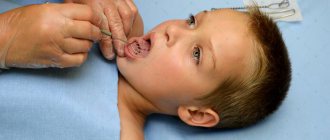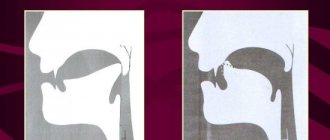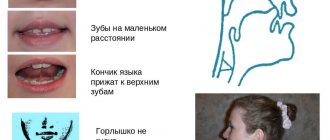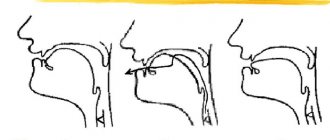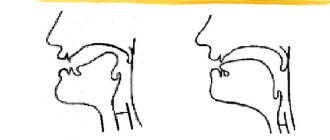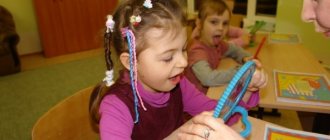Setting the sound P in stages
Lip exercises
- "Smile".
Smile so that the upper and lower teeth are visible and hold this position for 5-7 seconds. - "Tube".
Stretch your lips with a tube: 1st option - pronounce the sound [U] for a long time without using your voice; 2nd option - pull your lips slightly forward, as if forming a square; teeth are closed. - "The doors are opening." Slowly open your mouth until there is a distance of 10-15 mm between the upper and lower teeth, hold your lips in the “Smile” position.
Tongue exercises
Particular attention should be paid to exercises to control the muscles of the tongue. "Pancake." Place a wide, relaxed tongue on the lower lip. Make sure that the lower lip is not pulled over the teeth, and the upper teeth are also not covered by the upper lip (that is, the “Smile” position is maintained). If the tongue does not take the desired shape, pronounce the syllables “ba-ba-ba” with your tongue sticking out between your lips. Upon achieving success, make the tongue wide without pronouncing these syllables and blow until a groove is formed along the midline of the tongue.
- “Whose teeth are cleaner?”
Open your mouth slightly and use the tip of your tongue to “brush” the inside of your upper teeth, moving your tongue from side to side. - "Kitty."
Bend the wide tip of the tongue up towards the nose. If this movement does not work, then you should first practice licking the upper teeth under the lip from right to left, then licking the upper lip. - "Painter".
Smile, open your mouth and stroke the hard palate with the tip of your tongue, moving your tongue back and forth. - “Swing”
(inside the mouth). Bend the wide tip of the tongue alternately up and down between the teeth, gradually pulling it into the depths of the mouth. All movements should be done slowly, clearly, rhythmically with a mental count of “one-two” (up), “one-two” (down), etc., gradually accelerating the pace in subsequent sessions. - "Horse".
Click the tip of your tongue. Suck the tip of your tongue to the front edge of the roof of your mouth and tear it off, opening your mouth wide. - "Mushroom".
Lips in the “Smile” position, teeth open. Suck the front of your tongue to the hard palate. Holding the tongue in this position, connect and open the teeth until slight pain appears in the area of the hypoglossal ligament. - "Machine gun".
Smile, open your mouth and tap the tip of your tongue behind your upper teeth, repeatedly and clearly pronouncing the sound [D]: “d-d-d.” First pronounce the sound [D] slowly, then gradually speed up the tempo. - "The plane is buzzing."
Lips in the “Smile” position, the upper and lower teeth are visible, open by 10-15 mm. The wide tip of the tongue behind the upper teeth. Pronounce the sounds [Z] or [Zh] (you should get a sound reminiscent of the roar of a motor). Important: The lateral edges of the tongue should be pressed against the molars, the tip of the tongue should be thin and mobile, the lips should not be rounded.
If the child does not succeed in the “The plane is buzzing” exercise for a long time, then you can lift his tongue by the upper teeth with your fingers or a spatula. In this case, the child must pronounce “j-z-z-z” for a long time.
When and how to start
Therefore, if you or the child himself decides that something needs to be done about this, then you need to do it right away! Speech therapists say that the throat “r” is one of the most difficult problems that is problematic to eliminate. The sooner you start, the better. In adults, this defect cannot be cured, but in a child, correction can take a lot of time and require a fair amount of effort.
Of course, it's not all that bad. It happens that a speech therapist corrects the laryngeal “r” quite quickly, literally in a month or two, and in exceptional cases – in just a few sessions. But it is a mistake to think that “it will go away on its own.” It itself goes away extremely rarely, experts say, and it is better not to delay the elimination of this defect.
Methods for producing the sound R
- If the child successfully copes with all the exercises, you can begin to directly produce the sound P hard and Pb soft, using mechanical assistance: put a rubber pacifier on a wooden spatula and, placing the tongue in the position for the “The plane is buzzing” exercise, make quick oscillatory movements left and right or back and forth under the tip of the tongue until a steady vibration of the tongue is obtained. Staging the sound [P] using a pacifier is easier and faster in a lying position: the child’s head lies on the teacher’s lap. The mechanical method gives the child the opportunity to feel the vibration of the tongue, muscularly imprint it and subsequently reproduce it without mechanical assistance.
- It is sometimes possible to obtain vibration of the tongue using the following technique: place a thick ball of paper (tied to a long thread that the child holds in his hands) on the tip of the tongue, remove the tongue by the upper teeth and blow it off the tongue with a strong air stream. Important: It is necessary to strictly ensure that the child does not inhale the lump of paper.
- Another technique is based on the rapid repetition of the sound [D] in one exhalation, articulated in a special way: the child is asked to pronounce the sound [D] quickly and repeatedly (“dddddddddddd…”) with a half-open mouth (the tip of the tongue at the upper alveoli). The child should see quick strokes of the tip of the tongue in the mirror. The tempo of these beats gradually increases and the tip of the tongue vibrates at different rates. These rhythmic tongue strokes are then combined with vowels in forward and backward order, for example: ddda addd addda dddy yddd ydddy
While the child is performing these exercises, use a spatula placed under the front edge of the tongue to make frequent oscillatory movements, which causes a rumble characteristic of the sound [P] to be heard.
Think for yourself, decide for yourself
If you are sure that you want to keep your child's guttural "r" for life, then there is nothing to worry about. But it is advisable to demonstrate to him how he speaks using the example of other adults who have the same speech impediment, and ask whether he wants to speak the same way when he grows up. If the child confidently agrees, then forget about the speech therapist, you both like it so much and are happy, what else is needed?
But remember that a child with a speech impediment is unlikely to become a good speaker; he will never be hired as an announcer or actor, or any other public profession where it is important to speak beautifully. A child’s opinion about his pronunciation of the letter “r” may change over time, but then it will be too late to correct it.
Possible difficulties
If there is difficulty in performing these exercises with an open mouth or if “jumping” movements of the lower jaw are observed simultaneously with the work of the tongue, a wooden spatula or a rubber block (toothbrush) should be inserted from the side between the molars, which will act as a spacer. Soon there will be no need for mechanical fixation of the lower jaw.
Vibration of the tongue can be obtained without using a spatula if, at the moment of pronouncing “d-d-d”, you tap your palm below the chin. The child pronounces words with reverse syllables, the teacher taps his palm under the chin from below (for example, “a-d-d, i-d-d, ka-d-d, pa-d-d...”).
- When moving from the sound combinations “tr, dr” to syllables (dra-, tra-), children have difficulty pronouncing the syllables tra-, dra-. In this case, you can offer the child the following technique: clenching his fists, place them in front of his chest, and at the moment of pronouncing “dr-r-r-a”, sharply lower his hands down. You can combine saying “tra, dra” with jumping up on both legs and clapping your hands. Performing sharp and strong movements in combination with pronouncing syllables and short words switches the child from excessive concentration on articulatory movements and facilitates the transition from the isolated reproduction of sound combinations “tr, dr” to the introduction of sound into syllables and words. The same technique can be used if it is difficult to pronounce the sound [P] when combined with other consonants (“br-r, vr-r”): clench your fists tightly and, sharply lowering them down, say: brother, bravo.
- Sometimes a child can pronounce a whispered, dull, long sound [P] with clenched teeth. In this case, the child can be asked to pronounce the sounds “trr” by biting on a wooden spatula. By gradually increasing the distance between the teeth (to do this, bite down on a spatula folded in half or three), it is possible to obtain a prolonged pronunciation of the combination “tr-rr” with open teeth. After vibration has been achieved, through various exercises on the material of syllables, words and phrases, pronounced gradually at a faster pace, it is necessary to achieve automation of the learned articulation and get rid of the excessively rolling pronunciation of the sound [P].
- To obtain the sound [P], the child must be shown (in front of a mirror) the position of the tongue: the front edge of the tongue is not at the alveoli, but at the necks of the upper incisors. When, instead of a soft Pb, a hard sound [P] is obtained, it is necessary to achieve a gradual movement of the tongue forward, to the upper incisors, based on the combination of a consonant with the front vowel [I].
When automating the sounds P and Pb in words, one should take into account the child’s articulatory abilities, his age, and the ability to master the semantics and syllabic structure of the word. It is better to entrust this difficult task to a professional speech therapist.
General tips for organizing home activities
For classes to be effective, the following recommendations must be followed:
- Exercise regularly (daily if possible). Infrequent training will not produce any effect.
- The sequence of tasks is important: from simple to more complex (first, to reinforce pronunciation, give the child individual words, and then complex tongue twisters and rhymes).
- To practice sound, you should use a variety of materials, constantly coming up with something new to interest the child.
- During the lesson, the positive attitude of the child himself is very important: if at the moment he is in a bad mood or not feeling very well, it is better to postpone the training, for example, until the evening.
- Do not show your child that incorrect pronunciation of R is a serious problem. Let him perceive the speech therapy session as a game.
For the success of the lesson, the child’s positive attitude is very important, and the training should be presented as an exciting game.
Exercises to stretch the frenulum of the tongue
To eliminate a congenital defect, the help of a speech therapist is necessary - gymnastics is developed individually. It is better to practice in the form of a game, otherwise the baby will quickly lose interest in training.
Trying to reach the tip of the nose with your tongue helps to stretch the frenulum perfectly. The child must try as hard as possible, so it is recommended to offer a competition to see who can do it better. Conduct the lesson at least five times a day.
Another effective play exercise that allows you to cope with a defect is to invite your baby to try to eat like a kitten. You can simply reproduce the movements, but it is better to pour condensed milk into a plate and offer to “lick” it.
To quickly get rid of the defect, it is recommended to use massage. Be sure to do it with cleanly washed hands. The baby should open his mouth and lift his tongue up. Massage the frenulum with light movements, you can slightly pull it towards the teeth. It is better to carry out the first procedures under the supervision of a speech therapist - this will prevent mistakes. The duration of manipulation is no more than three minutes per day.
Articulation gymnastics
Articulation exercises are an important part of speech therapy. They prepare the organs for the development of sounds, train the muscular system
They are performed while sitting in front of a mirror every day, in a playful way.
There are general classes and specialized ones (for developing the “r”), thanks to which the frenulum is stretched and the tongue is fixed in a position on top.
Set of exercises:
Open your mouth, stretch out your tongue, try to reach your nose and chin. Open your mouth as much as possible. Place your tongue against your upper teeth. Then make movements down and up with great intensity. When the tongue touches the upper row of teeth, it is necessary to fix it in this position for 10 seconds. You can imitate a turkey. To do this, open your mouth slightly and place your tongue outstretched on your upper lip. Move the edge back and forth without lifting it from the lip. At the same time, try to pronounce “bl-bl-bl-bl-bl.” With your mouth closed, make movements like a paint brush throughout the entire oral cavity. The palate, cheeks, and teeth are affected. Stick out your tongue and quickly bite your lips. A prerequisite is intensive air blowing. Click your tongue several times (like a horse), stop and press your tongue tightly to the roof of your mouth for 10-15 seconds. Try to pull the bridle higher. Stretch a wide smile. Touch the tip of your tongue to the corner of your lips. On the count of “one,” move your tongue to another corner, and on the count of “two,” return to the starting position. As the exercise progresses, the movements become faster. Ask your child to count his own teeth. To do this, the end of the tongue must be tensed as much as possible. Touch each tooth with it, both outside and inside. Open your mouth in a wide smile, place your tongue on the roof of your mouth and relax. Now you need to open and close your mouth for 2 minutes
Immediately after this, relax. Within 3 minutes, the baby needs to pronounce the sound “d” with his mouth open. It is important to pronounce “z-z-z-z-z” long and drawn out, which helps develop the “r”.
Produces a strong and long-lasting air jet
Correct placement of fixed breathing plays an important role in sound production. A strong, targeted air stream should pass through the articulatory organs. This means that you need to teach your child to breathe and speak correctly at the same time. Often this is not so easy to do. With the help of the following series of exercises, you will understand how to correctly position your tongue and then produce a targeted air stream in the middle of the tongue:
1. Place your tongue in the “Pancake” position (see description above) and blow on it forcefully with your voice turned on. When the air vibrates, the tongue will vibrate.
2. “Snowflake”: place a small piece of cotton wool on the tip of your nose and take a deep breath through your nose. Place the tongue in the “Spoon” position (see description above). We press our tongue to the upper lip and forcefully exhale air from the mouth onto the tip of the tongue. A piece of cotton wool should fall off your nose.
3. We bring a scrap or piece of paper to our nose and aspirately pronounce the sound. When pronouncing each sound, a piece of paper should be shaken by a strong stream of air.
Automation exercises
Automation classes are necessary so that the baby can learn to correctly say words with “r” and phrases with such words. After such exercises and games, the baby begins to pronounce the sound correctly, without thinking.
Game " Repetition ". Tell your child about repeaters, that they are funny gnomes with huge ears, thanks to which they hear perfectly. Gnomes always strive to repeat what they hear. Turn to your child: “Show me what ears the repeaters have.” Big, big! “Now repeat: ro-ro-ro, ry-ry-ry, ru-ru-ru, ra-ra-ra.” The voice should sound at different heights and be either quiet or loud. The baby must repeat.
In pure tongues, the adult says the beginning of the phrase, and the baby must say its last word. Such activities simultaneously allow you to consolidate results and develop a sense of rhyme and rhythm.
Automation using pure words:
- ry-ry-ry what do we have in our hands? balls;
- ra-ra-ra continues? a game;
- ru-ru-ru kicking? ball;
- ro-ro-ro ball where did it fall? in a bucket;
- ar-ar-ar burns in the dark? flashlight;
- or-or-or went for a walk in? yard;
- ur-ur-ur what did the cat say? mur.
Advice You can come up with phrases for a speech therapy class yourself - the main thing is that the child has fun and interesting.
Game “ Echo ” - we teach a preschooler sound by repeating after an adult syllables that begin and end with [r]. For example, ra-ma-ra-ma, ma-ra-ma-ra, ur-ar-or, yr-ir-yur.
We learn the letter “ r ” in more complex syllables :
- gro-gro-gro;
- vry-three-kry;
- zra-zry-zru-zro;
- mra-gra-zhra;
- great-great-great.
Game “ The fourth odd one ”: name the child four syllables and ask him to name which one will be extra. For example, ka-ra-ka-ka, ro-ro-ru-ro, tru-tru-dru-tru, morning-morning-atr-morning.
After practicing with syllables, talk to your child about words that begin with them . For example, tru is a pipe, dro is a friend, dra is a dragon, tro is a path, tra is grass.
A preschooler will not be of much interest in lessons in which he repeats syllables or sentences after an adult. It is imperative to study and use funny children's poems, tasks, games, and pictures.
To automate [r] in sentences and words, you can ask the baby to clap his hands when he hears this sound, or repeat after an adult only words with [r] (speak words mixed with and without “r”). Invite your child to find flowers that have [r] in their names, for example, chamomile, rose.
What exercises can you do at home?
Exercises should be aimed at the reason why the child cannot pronounce this sound R.
Exercises for the hyoid ligament
This exercise improves the elasticity of the tongue muscle and develops its mobility. The exercise consists of the following:
- try to reach your nose with the tip;
- the tongue is pressed firmly to the palate and drawn towards the throat as far as possible;
- open your mouth, bend your tongue out as far as possible;
- carried out along the inside of the teeth in different directions;
- rolls up with a shovel and sticks out.
Exercises to develop mobility of the tip of the tongue
The sound P appears only when the tip vibrates. To develop this, there are special exercises:
- bite the tip;
- click the tongue pressed to the palate;
- the protruding tongue is pressed against the lip and air is exhaled, thereby creating vibration at its tip;
- pronounce the letters D, T with your mouth open.
- "D" and "T".
Statement P
Exercises aimed at correct pronunciation:
- R is pronounced in the position of the tongue in which the sounds D and T are pronounced, but with slight vibration. To do this, the tongue is pressed tightly against the palate and the air is exhaled.
- Say "DRRRRR" or "TRRRRR".
- Connecting to the sound of vowels, for example DRO, BRO, VRE.
- Pronounce words with a combination of the letters “tr” and “dr”.
- Consolidating the result with tongue twisters.
It is advisable to do all these exercises in front of a mirror and under the supervision of an adult, who should help and advise.
When correction is needed
The sound “R” is one of the most difficult sounds in a child’s speech development. It belongs to the category of sonorants, in which there are more vocal tones than noise.
Experts put “P” last, when all other sounds have already been correctly formed and consolidated. The production of “R” begins after 5.5-6 years. Until this time, a violation in his pronunciation is the age norm.
In some cases, it is worth contacting a speech therapist from the age of 4, when “R” appears in speech, but does not manifest itself correctly. In this variant, the child does not replace “R” with other sounds (“L”, “V”), but tries to pronounce “R”, but with disturbances in the articulatory apparatus.
Norm for pronunciation of “R”:
- lips are relaxed;
- distance between teeth 4-5 mm;
- the tip of the tongue rises to the upper gums;
- the tongue vibrates in the air stream;
- the middle part of the back of the tongue arches;
- the back of the tongue is directed back, pressed against the palate;
- the side edges are pressed upward;
- The vocal folds vibrate when speaking.
The main types of rhotacism that require correction:
- Velar. The tip of the tongue is lowered down and does not participate in articulation. The tongue is tense and pushed back. There is little voice in pronunciation, a lot of air. The sound is guttural and loud.
- Uvular. The tongue vibrates in the air stream. The sound is soft, quiet, smooth.
- Nasal. The air is directed into the nose, there is no vibration.
- Bilabial. Only the lips, without the tongue, take part in articulation.
- Slotted. The tongue is directed upward and forms a gap with the soft palate. The sound changes to “Z” or “Zh”.
- Interdental. The tongue is between the teeth.
Stages of correction of violations:
- Preparatory.
- Sound production.
- Automation.
- Differentiation.
- Consolidation in speech.
What prevents you from pronouncing the letter “r” correctly?
The main reasons why this sound is not pronounced are problems associated with the oral cavity.
Short hypoglossal ligament
Another name is bridle. It is this that prevents the tongue from moving freely. Usually this defect is corrected in the maternity hospital. It can also interfere with your baby's ability to latch onto the nipple properly during breastfeeding. If this defect was discovered at school age, it is stretched with speech therapy exercises.
Problems with phonemic awareness
Phonetic hearing is the ability to hear and perceive sounds correctly. At three years old, children should be able to distinguish sounds that are similar to each other, although they cannot yet pronounce them. In some cases, such disorders are associated with adenoids and other diseases. Thus, the child does not hear a certain sound and in his speech he replaces it with another similar one.
Incorrect speech breathing
To correctly pronounce sounds, including the letter P, you need to control your exhalation. Not all children can do this at an early age. Some raise their shoulders to do this, others do not know how to regulate their breathing during speech.
Bite
A correct bite involves the upper teeth overlapping the lower ones by about a third, the remaining teeth should close tightly together. With an incorrect bite, it is physiologically impossible to produce some sounds correctly. The child's bite will need to be corrected.
How can a child distort "R"
Incorrect “r” sounds are called rhotacism - these are the sounds that are replaced instead of this letter. Before determining exercises for producing the sound R, it is necessary to understand exactly how the child pronounces this sound. It happens like this:
- Burr or speaking through the throat. When pronounced, the palate vibrates instead of the tip of the tongue. A similar phenomenon is more typical for French, but not for Russian.
- Lateral "R". This happens if the side is pressed against the upper jaw, the opposite side hangs down. In this case, the tip cannot vibrate, and the sound P itself is more similar to “rl”.
- Single-stroke "r". Instead of shaking, the tip hits the roof of your mouth. This is how the English letter “R” is pronounced.
- Pronunciation through the nose. The air flow must pass through the mouth.
- Kucherskoe R. The tongue vibrates on the pressed lips, resulting in the sound “tpr”, not a pure R.
- Pararotacism. This is the phenomenon of replacing the sound P with another, for example G.L,V.
- Pass. The child simply does not pronounce this sound at all and misses it in his speech.
Levina's method
Rosa Evgenievna Levina created her own method in 1965, which consisted of articulation exercises for setting the letter R. At the beginning of the lessons, the fricative R is achieved, which does not have a characteristic vibration.
- The second stage is training the sounds Zh, Sh. You need to move your lips apart, but without rounding them. In this case, you need to pull out the sound Zh and move the tip of your tongue to the top.
- At the first stage, the exercises are aimed at obtaining the fricative "P" without vibration after achieving correct articulation.
- To obtain P, D is used, which must be pronounced while exhaling. The mouth should be open and the tongue connected to the upper gums.
Causes of impaired pronunciation of “vibrants”
Speech hearing
The main cause of rhotacism is phonemic hearing impairment. This should not be confused with deafness. Children with this problem have good physiological hearing. But they cannot distinguish phonemes of their native language by ear. If it is impossible to differentiate sounds, they are replaced in speech.
There are several reasons for phonemic hearing impairment. In the modern world, many parents prefer to teach their children to watch cartoons, films and other television products from infancy. All of them are created using computer programs. Artificial speech is characterized by shrillness, loudness and sudden jumps in intonation. As a result, the child, without hearing a sample of normal speech, does not learn to distinguish it and separate it from the general noise.
Talk to your child more, pronounce words correctly, don’t “lisp”
Testing phonemic awareness is very easy. To do this, the child is presented with a series of pictures. On the first one, he must find an object with a given vowel. For example, find all pictures with the sound “and”. Next, he must do a similar task, but with a consonant. Afterwards he is asked to identify the first sound in the words “stork”, “cloud”, etc. The composition of words gradually becomes more complex.
